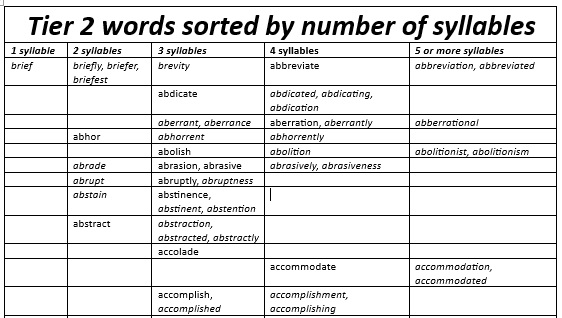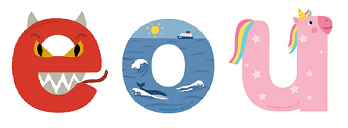Does this child need formal assessment?
0 Replies
It’s the last week of term here in wintry Melbourne, and many parents will be getting school reports saying their child has some reading and/or spelling difficulties, and suggesting further assessment.
Others will be worrying about their child’s skills, but being advised to wait and see if they catch up. Children often don’t catch up, and waiting for them to do so can waste valuable early intervention time.
A full developmental and educational assessment needs to be done by a psychologist, but can be quite expensive, and there are usually long waiting lists. If you think your child might have dyslexia/dysgraphia, please make sure your child does at least six months of high-quality intervention before seeking a diagnostic assessment, as that’s one of the diagnostic criteria for Specific Learning Disorder.
Speech pathologists can assess speech-language related aspects of reading and spelling, and provide recommendations, but again there’s usually a wait (though we have a few appointments available in North Fitzroy in the holidays, contact us here to find out more). Special educators can also assist with many assessments, but again those in the private sector often have long waiting lists, and if they’re school-based, they’re probably about to go on holidays.
If booking an assessment, make sure you find out how long it will take, what it will cover/include and how much it will cost beforehand. You don’t want to spend $1000+ on a 50-page report you don’t really understand, containing so many recommendations that you don’t know where to start.
AUSPELD online screener and parent website
The AUSPELD website has a useful Next Steps Screening Tool designed to help parents work out whether to seek formal assessment and/or intervention for their child.
AUSPELD’s Understanding Learning Difficulties for Parents website also contains great information to help parents understand children’s learning difficulties, and think about what to do and who can help.
Words read accurately in a minute
The number of words a child can read accurately in a minute is a useful litmus test of whether a child may have a reading problem requiring further investigation. In very general terms (see detailed norms here), by the end of Grade 1 (second year of schooling), children should be able to read an age-level text at something like 50-60 words per minute, or one word per second. This should increase to about 80-100 words per minute by the end of Grade 2, and about 110-120 words per minute by the end of Grade 3.
By the end of primary school children should be able to read at around 150 words per minute. This is about a normal conversational speech rate, though of course auctioneers and people in paid political advertisements speak much faster. Our brains like to process language at about conversational speed, and find it harder to comprehend if it’s a lot slower. Try slowing a podcast down to 75% to experience this. It makes me want to throw my phone across the room.
Highly skilled readers can read much faster than people usually speak, up to 240-300 words per minute, though it depends on what they’re reading. A trashy novel is easier than a complex scientific article.
Don’t wait-to-fail
If your child seems to have a problem with reading and/or spelling, please don’t wait to see if they grow out of it. They might not, and reading and spelling are essential skills for school and life success.
What do kids’ names teach them about spelling?
0 RepliesThe first word a child often learns to read and write is their own name. What first impression of our writing system does this give little Charlie, Chloe and Charlotte?
Our current crop of 5-year-olds was born in 2018, so I googled most popular baby names 2018 and looked for names that wouldn’t surprise a child with complete faith in ‘sounds of letters’, alphabet song type phonics.
I found only one name: Max. Even that would surprise kids whose poster/song says letter ‘X’ represents /eks/ as in ‘x-ray’. Add Quinn if you know a doubled consonant is usually pronounced the same as a single one, and your poster/song doesn’t say letter ‘Q’ by itself represents /kw/.
However, most kids’ names have more than one syllable, and contain at least one unstressed vowel. Let’s assume kids aren’t phased by vowel reduction or doubled consonants. Now we can sound out Emma, Ella, Camilla, Madison, Elena, Addison, Bella, Stella, Anna, Allison, Benjamin, Cameron, Adam, Landon, Colton, Ezra, Hudson, Dominic, Jameson, Evan, Declan, and Weston. A total of 24 names out of 200.
Hmm. Let’s add names containing ‘long’ vowel sounds represented by one letter (‘a’ in apron, ‘e’ in even, ‘i’ in icy, ‘o’ in open, ‘u’ in unit). IMHO the best thing about letter names is that the vowel names are also relevant sounds (but kids who extrapolate this to consonant letters tend to write ‘spl’ for ‘spell’, ‘pn’ for ‘pen’ and ‘cr’ for ‘car’). A child able to manipulate vowel sounds in words can now sound out Ava, Zoe, Maya, Penelope, Lila, Nova, Hazel, Violet, Eva, Mason, Logan, Jacob, Leo, Caleb, Owen, David, Samuel, Eli, Nolan, Roman, Rowan, and Jason.
This brings us up to 46 of 200 names, or 50 if we count names with ‘long’ vowel sounds written with ‘split’/VCe/silent final e spellings: James, Zane, Miles, Grace, (though she has a funny /s/ spelling), and Luke (though his vowel sound is really /oo/, not /ue/ as in ‘tune’).
Three-quarters of this sample of kids’ names still contain unexplained spellings. I don’t understand why being able to spell one’s own name is considered such an important milestone for tinies. Spelling names can be very hard, though Vaughan, Traigh, Clodagh, Siobhan, Niamh and Leigh weren’t hot in 2018.
Kids can make more sense of unexpected spellings in their names (and other words) if they know:
- There are more speech sounds than letters, so we write many with letter combinations.
- Some spellings represent more than one sound.
Our Embedded Picture Mnemonic desk mats are one simple tool which can help teach these concepts. They have the alphabet on one side, and the other speech sounds on the flip side, for example:
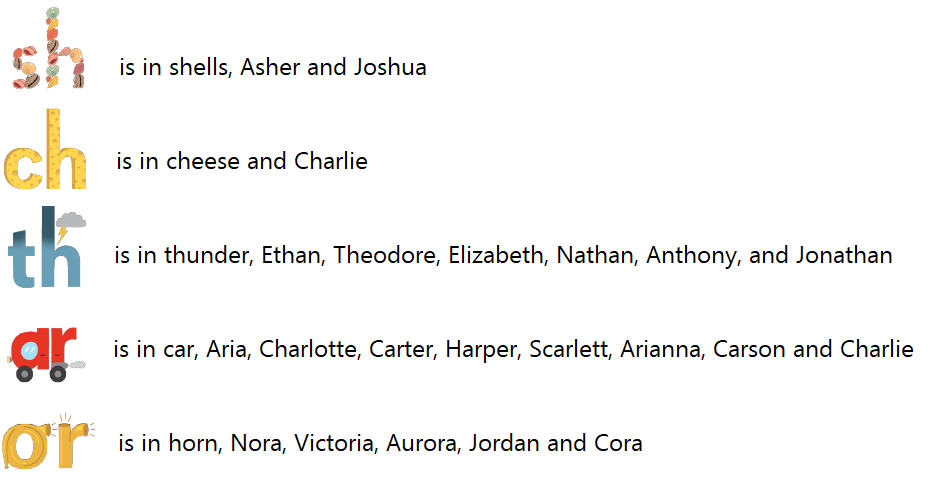
They also show shared spellings, as at the start of Asher and Ava, Evelyn and Ethan, Isabella and Isaac, Olivia and Owen, the ‘u’ in Hunter and Samuel and the ‘oo’ in Brooklyn and Cooper:
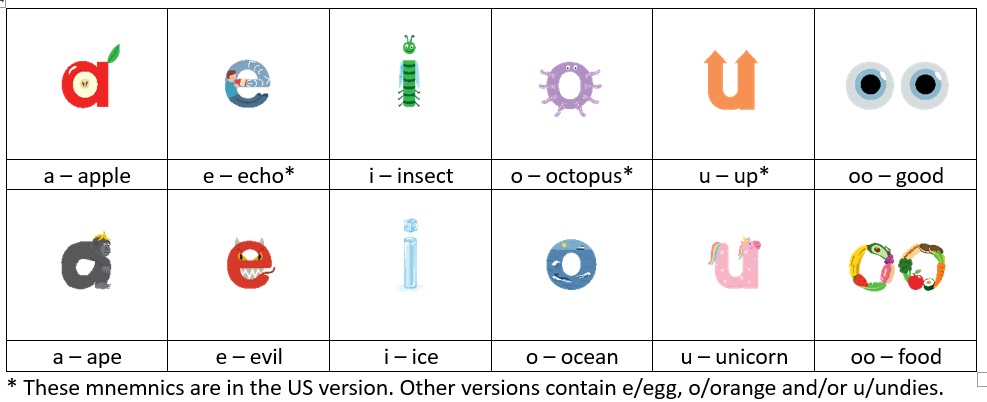
Confusion over harder sound-spelling relationships in names can be assuaged by teaching kids that most sounds are spelt a few ways, for example:
- The sound /ee/ is written ‘i’ in Sophia, Olivia, Aria, Amelia, Mia, Mila (depending on pronunciation), Aaliyah, Eliana, Arianna, Victoria, Emilia, Liliana, Lillian, Gabriella, Maria, Gianna, Naomi, Juliana, Vivian, Julia, Ezekiel, Damian, Xavier, Adrian, Gabriel, Sebastian, and Liam.
- /ee/ is written ‘ey’ at the end of Riley, Aubrey, Kinsley, Hailey, Paisley, and Audrey.
- /i/ is written ‘y’ in Dylan, and is unstressed in Adalyn, Evelyn, Madelyn, Brooklyn, and Jocelyn.
- /ie/ is written ‘y’ in Ryan, Wyatt, Skyler, Bryson, and Kylie.
- /k/ is written ‘ch’ in Chloe, Michael, Nicholas, Christian (from Greek).
- /f/ is written ph in Sophie, Sophia, Joseph and Christopher (also from Greek).
- /z/ is written ‘X’ in Xavier, Xander and Xena, though sadly the Warrior Princess’s name wasn’t trending in 2018 (again, Greek!).
During a recent conversation about where words come from, a tween with an unusually-spelt name told me she’d always wondered about the spelling of her name.
Please don’t leave the kids in your life wondering.
Tier 2 word structure
0 RepliesWhen teaching kids to read and spell polysyllable words, I’ve been trying to work with high-utility academic words, AKA Tier 2 Words. My main goal is to ensure learners can read and spell long words. All else being equal, they might as well practise this skill with words they can use across the curriculum.
Usually, I can’t realistically use the gold standard process outlined in the classic vocabulary selection text Bringing Words To Life for this. I only see clients once a week or fortnight, tweens and teens with learning difficulties tend not to communicate much about school topics, and their parents don’t always know what they are. Even when I do find out a school topic, prepare relevant work, and it’s time for their session, their class has often moved on.
So I tried a more generic approach: choosing words from the free grade-level Tier 2 wordlists on the Think SRSD website (thanks to its compilers, Karen Harris and colleagues at Hyde Park Central School District, and to the Think SRSD folk). However, these lists don’t sort words by number of syllables, and many words appear on more than one list. Often they are multi-morpheme words, like “endangered” (en+danger+ed), but useful base words like “danger” aren’t included, and nor are other useful derivations like “dangerous” or “endangering”.
To make the kind of list I wanted, I’ve combined the Think SRSD Tier 2 lists, deleted duplicates, sorted words alphabetically and by number of syllables, then added missing base words and extra derived forms in italics. My colleague Nicola Anglin and her parents (all excellent word nerds) made corrections and added words. We ended up with a 21-page document. Far too long to put in a blog post, but the top section is above, and you can download the whole thing as a pdf here.
If you find mistakes in the document (there are probably a few), want to suggest improvements or have other feedback, please send them in the comments.
New moveable alphabet and affixes
0 Replies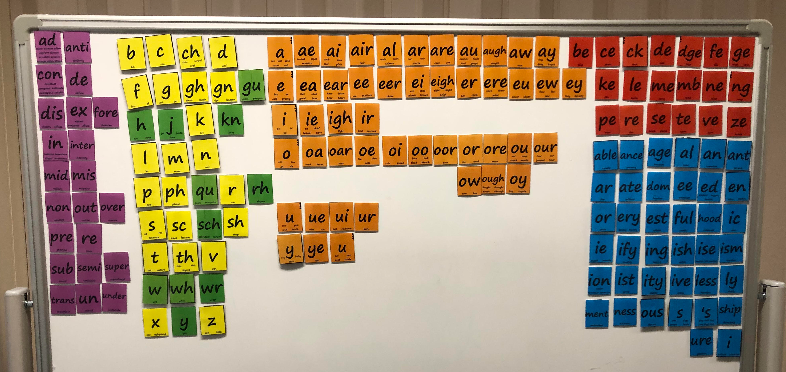
After many failed attempts and two broken laminators (gah), I’ve finally created a moveable alphabet which has lots of prefixes and suffixes but still leaves space on my whiteboard to write/build words, looks good and handles well (its chunkier tiles stick with a satisfying click, and don’t fall off easily).
The set has 140 single-sided tiles and 56 double-sided tiles, representing:
- 11 consonant spellings used before vowels, like ‘j’, ‘h’, ‘v’, ‘wh’ and ‘kn’ (these are green, like a traffic light’s ‘go’ signal),
- 48 vowel spellings like ‘u’, ‘ai’, ‘ea’, ‘oo’, ‘ur’, ‘igh’ and ‘ough’ (orange, meaning ‘caution’, because vowels are the trickiest part of English spelling).
- 36 consonant spellings used after vowels like ‘ck’, ‘ng’, ‘ff’, ‘ve’, ‘tch’, ‘ce’ and ‘mb’ (red, for stop and blend).
- 23 consonant spellings which are used both before and after vowels, like ‘k’, ‘m’, ‘s’, ‘sh’ and ‘ph’ (yellow).
- 22 prefixes (purple).
- 50 suffixes (blue).
All tiles are now the same size, making them easier to cut up and store/carry in a toolbox, if you’re on the go. There are two or three copies of high-use tiles, so you shouldn’t run out of letters like ‘e’ or ‘n’ when building long words (spares not shown in photos above and below). Having double-sided tiles makes the set more compact, and helps establish the concept that speech sounds/affixes are often written more than one way. The photo below shows the ‘flip’ side (as the vinyl buffs say) of the double-sided tiles.
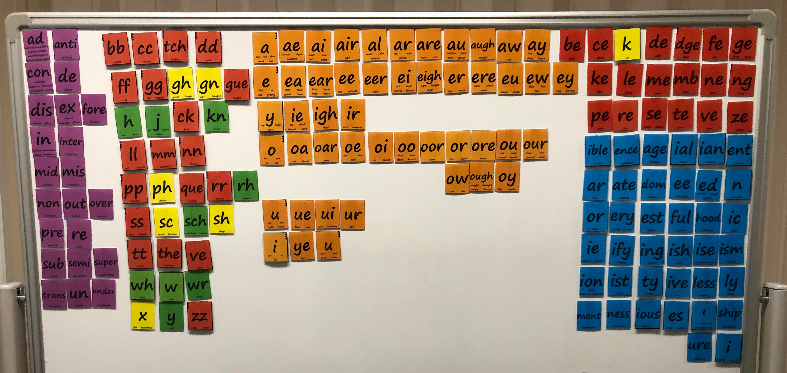
Early, low-verbiage morphology teaching
As well as using this set to build and change words using graphemes, these tiles help you show children how to add prefixes and suffixes to base words without resorting to complex ‘if-then’, ‘except-if’ type language, which young and language-disordered children find hard to understand.
For example, build the word sun, then add:
- suffix -s, to make suns, as in ‘the lizard suns itself on a rock’ (3rd person verb) or ‘many stars are suns’ (plural).
- suffix -‘s, to make sun’s, as in ‘the sun’s rays are bright today’ (possessive)
- suffix -ed, to make sunned, as in ‘the snake sunned itself on that rock yesterday’ (past tense) or ‘He had sunned himself for years, so his skin was leathery’ (past participle). Kids can be told that ‘suned’ is pronounced rhyming with ‘pruned’, so when a vowel suffix is added, we flip the ‘n’ over to get ‘nn’, which keeps the /u/ sound in ‘sun’.
- suffix -ing, to make sunning, as in ‘sunning yourself feels nice, but don’t get burnt’ (present participle). Again, flip the ‘n’ tile over to get ‘nn’.
- suffix -y, to make sunny, as in ‘It’s a lovely, sunny day’ (again, flip the ‘n’).
Some kids get a real six-words-for-the-price-of-one buzz from this. They want to try other prefixes and suffixes, to see what other words they can make. I’ve had to ask a few of them to stop it and sit down, because we have other work to do.
This set also makes it easy to teach the concept that spellings can stay the same when sounds change during word-building e.g.
- Build the word heave, with vowel sound /ee/ represented by ‘ea’, then add suffix -y to get heavy, with vowel sound /e/ represented by ‘ea’.
- Build the word south and notice that the vowel sound changes, but the spelling stays the same, when we add suffix -ern to make southern.
- Build words like act, music and discuss, and notice how their last sounds change when we add suffix -ion to get action, musician and discussion. Preserving base word spellings helps us know what the new word means.
Each tile has example words showing the different ways the spelling can be pronounced. Usually there are only one or two ways, but some spellings have small groups of unusual words (like grapheme ear: bear, pear, wear, tear, swear and heart).
Some prefixes assimilate to base words, for example ‘in’ meaning ‘not’ changes to ‘im’ when added to words starting with lip sounds, like ‘possible’ and ‘modest’. Example words on prefix tiles illustrate this.

This set doesn’t include the six ‘split vowel’ spellings in previous moveable alphabets: a…e as in ‘make’, e…e as in ‘these’, i…e as in ‘like’, o…e as in ‘hope’, u…e as in ‘cute/flute’ and y…e as in ‘type’. Their unusual shape was a bit distracting and fiddly, and they required different logic, potentially adding cognitive load.
The original sets already had several word-final consonant-e spellings: ce as in voice, ge as in large, le as in bottle, se as in house/please, ve as in give, ze as in breeze. Replacing the ‘split’ spellings with extra consonant-e spellings (be, de, fe, ke, me, ne, pe, re and te) only adds three extra graphemes, follows the same left-to-right logic of the rest of the set, and makes it easier to build common words like ‘come/some’ and ‘done/gone’. These reasons, plus ease of making/handling/storing tiles have motivated the change. Sorry about that, if you prefer ‘split’ spellings, but please listen to Episode 11 of the Sounds-Write podcast. You might also be persuaded.
If you already have a serviceable Spelfabet or other moveable alphabet, you can add the new bits of this one to it, keeping the file on your computer so you can print, assemble and use it in full once your existing set finally bites the dust.
Now I just need to revise my wordlists and sequences to match this version of the alphabet. Please bear with me while I do. If you have any feedback about this version, I’d love you to put it in the comments.
Free online professional learning
0 Replies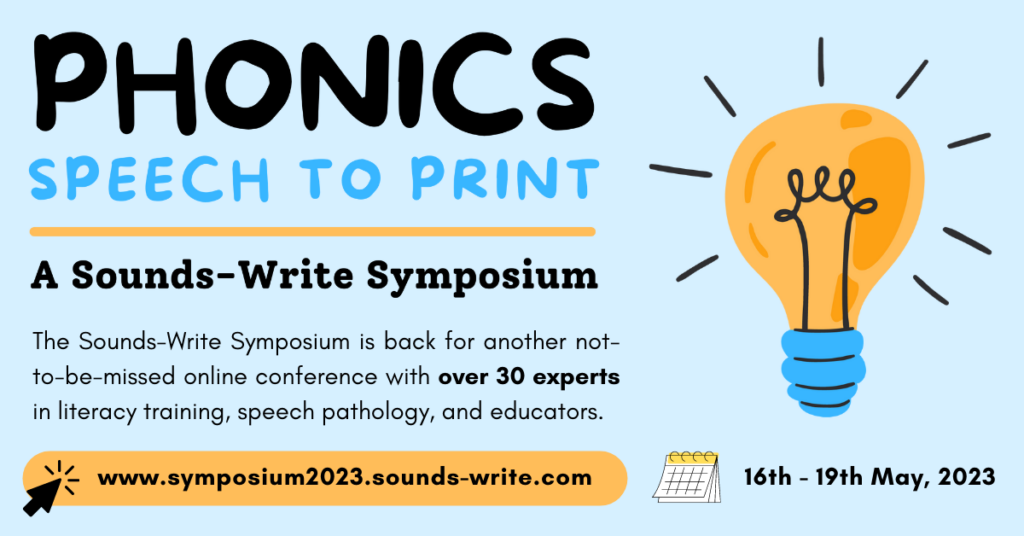
Yikes, 6036 people have signed up for my Phonics: Speech To Print Symposium talk next week. This event is shaping up to be bigger than Ben Hur, not surprising when speakers include Pamela Snow, Greg Ashman, Mandy Nayton, Tom Bennett, Pie Corbett, John Walker and many more.
All sessions are free for 48 hours, or an all-access pass to all sessions whenever it suits you is very affordable, e.g. a whole school pass costs about AUD$225 if you sign up before 15/5/23.
The good folk of Sounds-Write have involved many other speech-to-print authors like Tricia Millar (That Reading/Spelling Thing), Marnie Ginsberg (Reading Simplified), Nora Chahbazi (EBLI), Tami Reis-Frankfort (Phonic Books), Faith Borokowski (High Five Literacy) and Ann Sullivan (Phonics for SEN). Making sure everyone can read is a team sport, and we can all learn so much from each other.
For example, Nora Chahbazi and John Walker agreed in Episode 11 of the Sounds-Write podcast that teaching consonant-e as a word-final spelling (e.g. ke in ‘take’, ‘se’ in these, ‘ne’ in line, ‘pe’ in hope, ‘te’ in cute) is probably a better idea than teaching kids about ‘split’ spellings (a…e as in ‘take’, e…e as in these etc). ‘Split’ spellings mess with straightforward left-to-right reading. Hmm.
New moveable alphabet
I’ve been working on a new moveable alphabet, adding prefixes and suffixes, and making it more compact and useful for showing (rather than telling) kids how words are built. The kids I work with can’t handle too much verbiage.
Earlier versions have consonant-e spellings: ce in ‘voice’, se in ‘house/please’, ge in ‘large’, ve in ‘have’, ze in ‘breeze’ and ‘le’ in ‘bottle’, but after listening to the above podcast I added more, and took out the ‘split’ spellings. This makes it easier to build common words like ‘done’, ‘gone’, ‘come’ and ‘some’.
There are also double-sided tiles you flip over to change y to i when ‘cry’ becomes ‘cried’, or ‘n’ to ‘nn’ when ‘run’ becomes ‘running’, etc. I’ll demonstrate this in my symposium session.
New Embedded Picture Mnemonics
We’ve also been working on, and I’ll talk at the symposium about, the Spelfabet embedded picture mnemonics. Lots of people want a picture mnemonic for every grapheme. More of a good thing is not always better. The mnemonics exist to help kids remember basic sound-letter relationships, understand that there are more sounds than letters, and teach a common spelling for each sound. This is consistent with the late, great Prof Diane McGuinness’s prototype for teaching the spelling code. She seems to have inspired the authors of many speech-to-print phonics teaching approaches.
The Spelfabet embedded picture mnemonics will soon have single-letter ‘long’ vowels: a/alien, e/evil, i/ice, o/ocean, u/unicorn. Most words in English are polysyllabic, so the one-letter spellings are generally the most common for these sounds (see this study). I hope the new mnemonics help shift people’s focus from graphemes to phonemes, and help kids realise that many sounds share a spelling (it’s not just oo/look and oo/food).
High-utility polysyllabic word list
Finally, we’ve been working on a high-utility academic (Tier 2) polysyllabic word list, which again will be available next week. When teaching kids in intervention how to read/spell polysyllable words, the aim is to prioritise words they can use across academic subjects, such as “benefit” and “argument”. Words like “flamenco” and “saxophone” aren’t quite so useful.
The list also aims to build morphological knowledge into intervention targeting polysyllable words. It contains lots of inflected and derived forms. Knowing how to turn a base word like “avoid” into “avoidant”, “avoiding”, “avoided”, “avoidable” and “unavoidable” gives a six-for-the-price-of-one frisson to learning about word structure, and makes complete sense to kids who are into Minecraft and Lego (at least half my caseload).
I’m also planning to offer a substantial Spelfabet shop discount to symposium attendees.
I hope at least some of the Phonics: Speech To Print Symposium next week is interesting/useful to you.
Alison Clarke
Speech Pathologist
New Phonics With Feeling books
0 Replies
The new Extended Code Set Eleven download-and-print Phonics With Feeling readers mean there are now a dozen sets of these affordable, decodable books (one Initial Code Review set, and 11 Extended Code sets).
Set Eleven has five volumes containing 13 short stories in verse. Its focus is less common consonant spellings like the ‘kn’ in ‘know’ and the ‘ch’ in ‘chorus’, so it’s suitable for students in Year 2 or early Year 3, or slightly older catch-up learners.
It can be difficult to find text which provides plenty of practice with less common patterns, but author and illustrator Gaia (AKA Teresa, but her grandkids call her Gaia, and she created the books for them) Dovey has a knack for weaving amusing stories including lots of words with (a) specific phoneme-grapheme correspondence(s). Great for repetition to mastery!
Like all PWF sets, there’s a parent/aide version which may be printed up to five times (40c per copy), or a bulk-priced teacher/clinician version, which may be printed up to thirty times (20c per copy). They download with printable quizzes about each book, or you can use the online quizzes.
The stories are:
Triceratops Stew (250 words)
- Revising c as in cent, introducing ce as in prince
- In this story, the reader is encouraged to try a ridiculously impossible recipe.
The Gentle Giant (277 words)
- Revising g as in giant, introducing ge as in change
- This giant is gentle and kind, but small animals need to be vigilant around him.
Missy Madge (121 words)
- Introducing dg as in budget, dge as in badge
- Missy Madge is a brave little donkey who goes everywhere with her owner.
The Animals and the Alphabet (179 words)
- Introducing ph as in alphabet
- Some animals at the zoo are learning the alphabet, and others are feeling left out.
The Giraffe Who Forgot How to Laugh (151 words)
- Introducing gh as in laugh
- Joseph the giraffe has had a tough time in the zoo, but there is a simple way to make his life easier.
Write About Wrong (221 words)
- Introducing wr as in wrong
- Proteus, the protector of the sea, wants to get a message to those people who don’t care about the earth or the ocean.
The Knitting Knight (92 words)
- Introducing kn as in knit
- This knight seems to be pretty good at knitting, but he is taking a long time to make a scarf.
The Gnarled Old Gnome (80 words)
Introducing gn as in gnome
- This old gnome is keen to travel, but when he visits the city, he doesn’t like it at all.
Chiara and the Cats’ Chorus (224 words)
- Introducing ch as in chorus
- The cats in the chorus want tiaras like Chiara’s, so she finds a way to make this possible.
Ghosts and Ghouls (93 words)
- Introducing gh as in ghosts
- On her brother’s advice, Sally creates a suitably ghastly costume for Hallowe’en.
Tom Crumb (125 words)
- Introducing mb as in crumb
- Tom does some silly things, but he also does something brave.
What About Whale? (124 words)
Revising wh as in whale
- This little poem reminds children that there are plenty of words beginning with wh, and draws attention to the way in which many of these words are onomatopoeic.
Priscilla (348 words)
- Introducing sc as in scissors, sce as in reminisce
- Priscilla is interested only in herself and in the fashion scene, but she learns the hard way about collaboration.
Like the other Phonics With Feeling readers, these readers have cohesive narratives, entertaining plots, engaging characters and themes worth talking about. We hope you like them!
Embedded Picture Mnemonic bookmarks and desk mats
0 RepliesHelp beginners link speech sounds and letters/spellings with our new, printable embedded picture mnemonic bookmarks and desk mats.
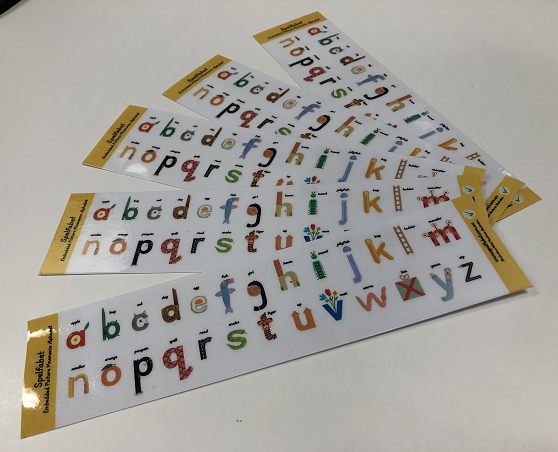
The bookmarks are single-sided, with one mnemonic for each letter of the alphabet. Five print to an A4 page. Save, print, laminate and cut up for distribution to literacy beginners. If/when some are lost/damaged, just print extras.
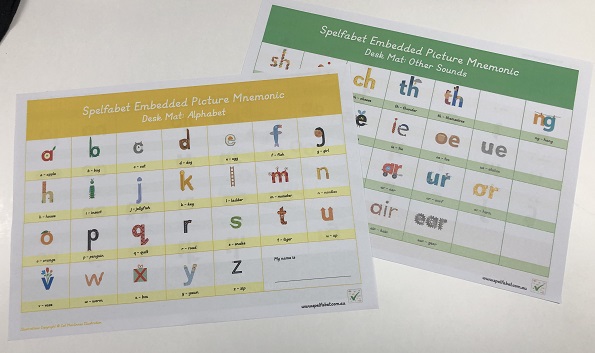
The desk mats have the alphabet on one side, and a mnemonic for each of the other sounds on the flip side. Print just the first side for beginners, or both sides to show learners that there are more sounds than letters, so many are written with letter combinations.
There are three versions, to suit different accents and preferences, all with the new y/yawn mnemonic:
- A version for most Australian, UK, NZ and other speakers of non-rhotic Englishes, with e/egg, k/key, o/orange, u/up, ur/surf, air/hair and ear/gears.
- A more Aussie version as above, but with k/kangaroo and u/undies (yes! back by popular demand).
- A version for US, Canadian and other speakers of rhotic accents, with e/echo, k/key, o/octopus, u/up, wh/whale, ur/burn, and aw/claw, but no air/hair or ear/gears.
Prices assume each purchaser will print enough for their class/caseload.
We hope you like them!


